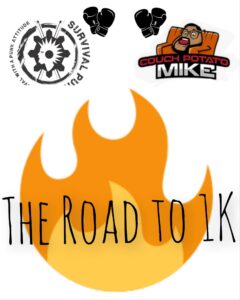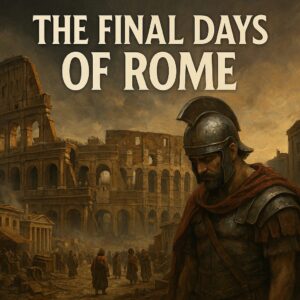Go offline with the Player FM app!
The Final Days of Rome: What Collapse Really Looks Like | Episode 394
Manage episode 477352555 series 60512
The Final Days of Rome: What Collapse Really Looks Like | Episode 394
Why Rome Still Matters
When we think about collapse, we often imagine something fast and fiery—EMP blasts, mushroom clouds, or sudden civil war. But history rarely works that way. The fall of Rome was not a single event, but a long, grinding decline. And in many ways, it’s the best case study we have for what collapse actually looks like—especially when it happens to a civilization that once seemed untouchable.
In Episode 394, we’re diving into the final days of the Western Roman Empire. Not just the battles or invasions—but what life was like for ordinary people. What broke down, what stayed functional, and what the warning signs were that the end wasn’t just coming—it had already started.
The Slow Collapse of an Empire
Rome didn’t fall in a day. It took centuries. The economy weakened, currency was debased, infrastructure decayed, the military became unreliable, and political corruption exploded. Sound familiar?
By the 4th and 5th centuries, people living in the empire weren’t watching it fall—they were adapting to it. Cities were shrinking. Roads were no longer repaired. Merchants stopped accepting Roman coins and started bartering instead. The government was technically still in place, but trust was gone.
Daily Life in Decline
For the average Roman citizen, the final years of the empire didn’t always feel like a dramatic end. It felt like constant change, stress, and uncertainty. Law enforcement became unreliable or predatory. Food prices soared. Once-safe roads became dangerous. Trade routes dried up. More and more people retreated to rural life, relying on local communities and land to survive.
We imagine collapse as war or disaster—but for most Romans, it looked like decay. Services stopped working. Bureaucracy broke down. The elite fled. And people were left to fend for themselves.
Who Survived?
It wasn’t the richest or most powerful. In fact, many elites lost everything when the system collapsed. The survivors were the ones who could adapt—who had local networks, practical skills, land, and the ability to live with less.
Christian monks and rural peasants often fared better than city elites. Why? Because they already lived with low expectations, had tight-knit communities, and weren’t dependent on the system continuing.
Lessons for Modern Preppers
The parallels to today are eerie. Rising inflation, overextended governments, corruption, shrinking middle class, growing tribalism—these aren’t just modern issues. They were the warning signs of Rome’s end too.
Prepping for a “Rome-style” collapse means:
- Relying less on central systems
- Building local resilience and community
- Having real-world skills and something to trade
- Expecting the decline to be slow, not sudden
- Watching for shifts in trust, currency, and law
Final Thoughts
The fall of Rome wasn’t about a single battle. It was about a system that got too big, too corrupt, and too fragile to maintain itself. People didn’t all die—they adapted. But the ones who survived and thrived weren’t the ones with the most stuff. They were the ones who read the signs early and started changing how they lived.
We’re not saying modern civilization is Rome. But if it was, the final chapter would already be underway. The good news? History shows us that collapse isn’t the end. It’s the beginning of something new. The question is—are you ready for it?
Links
Think this post was worth 20 cents? Consider joiningThe Survivalpunk Army and get access to exclusivecontent and discounts! |
Don’t forget to join in on the road to 1k! Help James Survivalpunk Beat Couch Potato Mike to 1k subscribers on Youtube

Want To help make sure there is a podcast Each and every week? Join us on Patreon
Subscribe to the Survival Punk Survival Podcast. The most electrifying podcast on survival entertainment.
Like this post? Consider signing up for my email list here > Subscribe
Join Our Exciting Facebook Group and get involved Survival Punk Punk’s
The post The Final Days of Rome: What Collapse Really Looks Like | Episode 394 appeared first on Survivalpunk.
52 episodes
Manage episode 477352555 series 60512
The Final Days of Rome: What Collapse Really Looks Like | Episode 394
Why Rome Still Matters
When we think about collapse, we often imagine something fast and fiery—EMP blasts, mushroom clouds, or sudden civil war. But history rarely works that way. The fall of Rome was not a single event, but a long, grinding decline. And in many ways, it’s the best case study we have for what collapse actually looks like—especially when it happens to a civilization that once seemed untouchable.
In Episode 394, we’re diving into the final days of the Western Roman Empire. Not just the battles or invasions—but what life was like for ordinary people. What broke down, what stayed functional, and what the warning signs were that the end wasn’t just coming—it had already started.
The Slow Collapse of an Empire
Rome didn’t fall in a day. It took centuries. The economy weakened, currency was debased, infrastructure decayed, the military became unreliable, and political corruption exploded. Sound familiar?
By the 4th and 5th centuries, people living in the empire weren’t watching it fall—they were adapting to it. Cities were shrinking. Roads were no longer repaired. Merchants stopped accepting Roman coins and started bartering instead. The government was technically still in place, but trust was gone.
Daily Life in Decline
For the average Roman citizen, the final years of the empire didn’t always feel like a dramatic end. It felt like constant change, stress, and uncertainty. Law enforcement became unreliable or predatory. Food prices soared. Once-safe roads became dangerous. Trade routes dried up. More and more people retreated to rural life, relying on local communities and land to survive.
We imagine collapse as war or disaster—but for most Romans, it looked like decay. Services stopped working. Bureaucracy broke down. The elite fled. And people were left to fend for themselves.
Who Survived?
It wasn’t the richest or most powerful. In fact, many elites lost everything when the system collapsed. The survivors were the ones who could adapt—who had local networks, practical skills, land, and the ability to live with less.
Christian monks and rural peasants often fared better than city elites. Why? Because they already lived with low expectations, had tight-knit communities, and weren’t dependent on the system continuing.
Lessons for Modern Preppers
The parallels to today are eerie. Rising inflation, overextended governments, corruption, shrinking middle class, growing tribalism—these aren’t just modern issues. They were the warning signs of Rome’s end too.
Prepping for a “Rome-style” collapse means:
- Relying less on central systems
- Building local resilience and community
- Having real-world skills and something to trade
- Expecting the decline to be slow, not sudden
- Watching for shifts in trust, currency, and law
Final Thoughts
The fall of Rome wasn’t about a single battle. It was about a system that got too big, too corrupt, and too fragile to maintain itself. People didn’t all die—they adapted. But the ones who survived and thrived weren’t the ones with the most stuff. They were the ones who read the signs early and started changing how they lived.
We’re not saying modern civilization is Rome. But if it was, the final chapter would already be underway. The good news? History shows us that collapse isn’t the end. It’s the beginning of something new. The question is—are you ready for it?
Links
Think this post was worth 20 cents? Consider joiningThe Survivalpunk Army and get access to exclusivecontent and discounts! |
Don’t forget to join in on the road to 1k! Help James Survivalpunk Beat Couch Potato Mike to 1k subscribers on Youtube

Want To help make sure there is a podcast Each and every week? Join us on Patreon
Subscribe to the Survival Punk Survival Podcast. The most electrifying podcast on survival entertainment.
Like this post? Consider signing up for my email list here > Subscribe
Join Our Exciting Facebook Group and get involved Survival Punk Punk’s
The post The Final Days of Rome: What Collapse Really Looks Like | Episode 394 appeared first on Survivalpunk.
52 episodes
All episodes
×Welcome to Player FM!
Player FM is scanning the web for high-quality podcasts for you to enjoy right now. It's the best podcast app and works on Android, iPhone, and the web. Signup to sync subscriptions across devices.





